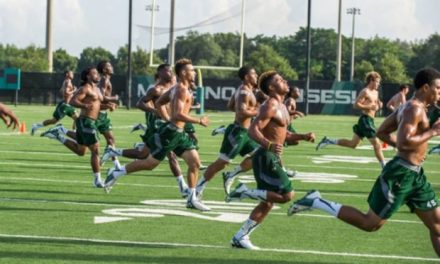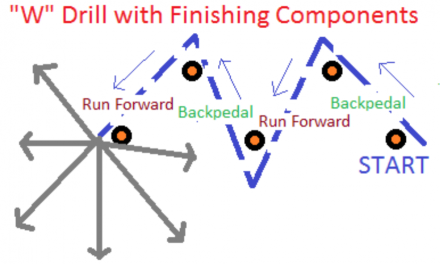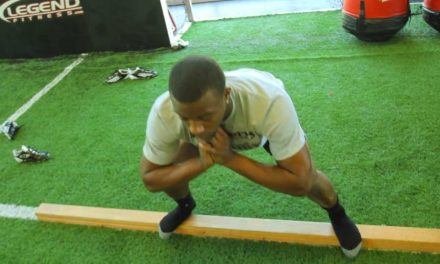When coaches think of the characteristics of great football strength and conditioning programs we usually talk about size, strength, speed, effort level, toughness, and coachability.
If you went to see football workouts at almost any school, they are working on those things.
So, what separates great programs from good programs?
It’s obvious what separates the bad programs from the good programs because it usually has a lot to do with talent.
But what do you do when you are trying to get over the hump and win a state championship, instead of just being a playoff participant?
The answer is that your strength & conditioning program you create must provide an advantage.
Over the years, I have been very lucky that the programs that hire my company are already good but are trying to be great by looking for every possible advantage.
My company hardly ever gets hired by losing programs.
While going into these good programs I noticed there are some common characteristics that are inhibiting them from greatness and some slight changes have made a vast difference.
The difference between good programs and great football strength and conditioning programs is great programs…
- Have a full-year plan
- Teach transitions in speed training
- Build different types of strength
- Have a comprehensive testing system
GREAT FOOTBALL STRENGTH AND CONDITIONING PROGRAMS HAVE A FULL YEAR PLAN
I am not saying that you have to follow my plan but everyone needs a detailed plan. Many coaches say they like to be fluid with their workouts and adjust, on the fly, to their athletes’ needs, and there is some truth in that. But in reality, I am seeing that they make things up as they go, and do not have a consistent programming map that will ensure results. You must start with a plan and you can then make minor adjustments daily and weekly. Training is an art and a science so everyone will need to adjust.
Here is an example of how to organize off-season training: Off-Season Workout Example
Now that you have reviewed the workout example, there are some details that you will have to program into your off-season workouts:
- Create deloading weeks where you cut down on the amount of sets, reps, and weight for that week. If you look at most college strength programs, they have a deloading week about every 5-6 weeks. In our high school programs, this happens organically because of spring break, holidays, kids missing school and training sessions, and snow days. This was even more apparent this year with the COVID Quarantines that we all faced. Even if you do not specifically program a deloading week pay attention to your athletes to know when to decrease the intensity.
- According to USA Track & Field, there should also be a change-up week every 5-6 weeks. This week should be a shock to their system and bring different stresses upon the body. If you lift a lot of heavy weights, then the change-up week will be low weight with high reps. The converse would also be true.
- Match your lifting and your running to meet your goals. For example, if you were training four days a week, you could do two days of upper-body lifting paired with your speed and agility and then two days of lower-body lifting paired with very hard finishing exercises and conditioning. It is hard to make this perfect but all programs can do their best.
Here is an example of how to organize your in-season calendar: In-Season Workout Calendar
When creating your in-season calendar ask yourself the following questions:
When will the season most likely end?
This is the most important question and determines every other decision that is made for the entire year. Do not feel bad if your answer is “we are just trying to make it to the playoffs”. Do not feel bad if you are just trying to win as many games as possible because you are not very talented. In high school football, we all have peaks and valleys so our ending dates will differ each year. Once you have this date set then you will build your calendar backwards just like a track coach. The first practice and workout you design should be the day before your assumed last game, and then work backward.
When will we taper?
This question can only be answered after you answer the previous question. Tapering should begin about three weeks before your assumed last game. Tapering can look two different ways. One way is to keep the same amount of practice time while decreasing the intensity and increasing the amount of rest. A second option is to decrease the amount of practice time while still keeping the same intensity and rest time. I believe the second option is better, as high school athletes have a short attention span.
During the season, programs should transition from work being more important than rest to eventually rest being more important than work. At some point, being healthy is more important than making sure you get one more rep of Inside Zone. This is a hard balance to find because there are so many variables to these decisions. In one of the state semifinals, we ran Inside Zone Kick 25 times and our hybrid FB/TE had to kick-out an eventual Big Ten defensive end each time. He had a great game and was obviously beat up but we did not give him sufficient rest during the state championship week so he could get his body healed. He struggled in the state championship game, which we lost in the last 30 seconds. To this day Il feel like I lost that game for us because I did not respond to our athletes’ needs, and therefore our offense did not perform as well as normal.
I have trained and coached football teams that did not start tapering until after the first playoff game (we won the state championship one year and lost it one year) and other teams that started tapering during week seven, due to the fact that we had to win every game to make it to the playoffs from that point forward. I have also coached a team where we made sure that we were fresh every Friday because they won 1 game the year before (we won 6 games and barely missed the playoffs). One year I had a basketball team that did not start tapering until after the sectional championship game (lost in the state semifinals). Every season is different.
How can I get an extended rest period during the season?
This is a hard question to answer because of most team’s regimented schedules. One answer is taking the weekend off after a very easy game (if you have one). At one high school, we were going to beat a team by at least 50 points so we did not bring them in on Saturday for workouts or film. Watching the film would have been pointless. It was also the perfect weekend because they had the Homecoming Dance that Saturday and we wanted to get them as much rest as possible on Friday night and Saturday afternoon.
Is the preseason an extension of the off-season or the in-season?
I like to deal with the preseason as an extension of the off-season so we can get a few extra weeks of high quality work. During the preseason, I err on the side of working too hard since we are not trying to get ready for games and since we have nothing for which to peak.
Should we do football strength and conditioning through any games?
If you are certain that you are going to win a game, then you can train through it and there is no reason to rest for it. You can make that week very hard so then you can pull back on a week when you need to be fresh. Do you care if you win by 30 or 40 points? Would you be alright with winning by “only 30” if that helped push your program closer to a state championship? If you know your goal is possibly winning the state championship, then you do not want to be fresh each week. If you taper too early, you will not be at your best by the state championship game and if you want to be your best for the big game, you have to train through some of your easier games.
GREAT FOOTBALL STRENGTH AND CONDITIONING PROGRAMS TEACH TRANSITIONS IN SPEED TRAINING
Good football programs work on linear speed, agility drills, and jump training. The great schools try to teach football skills within these exercises. The best way to teach football skills within your drills is to make sure that players can perform all of the required football transitions. Speed drills need to consistently combine running, jumping, and cutting in all directions so athletes are constantly practicing within the rigors and demands of a football game. Here are some examples that will spark some ideas:
Combining Running, Jumping, and Agility
Combining Jumping Over Big & Little Hurdles and Sprinting
GREAT FOOTBALL STRENGTH AND CONDITIONING PROGRAMS BUILD DIFFERENT TYPES OF STRENGTH
When developing a strength program, good programs lift weights but great programs develop different types of strengths. All football players need to be able to be explosive, resist forces, and hold forces in place. All of those types will improve by doing any type of strength training. But if players focus on strength and hypertrophy, they can make great gains toward being the best versions of themselves. The different types of strength are:
Ballistic Lifting
Why: Muscles need to learn to move weight fast and transition quickly
Muscle Adaptation: Speed & Power
Example Video: Ballistic Bench Press
Cadence: Fast down and fast up
Weight Used: 40-45% of their 1-Rep Max
Football Application: Used for developing speed and power to Throw, Kick, and Strike
Dynamic Lifting
Why: Muscles need to learn to move weight fast and transition quickly
Muscle Adaptation: Speed & Power
Example Video: Dynamic Bench Press
Cadence: Normal down and fast up
Weight Used: 40-45% of their 1-Rep Max
Football Application: Used for developing speed and power to Throw, Kick, and Strike
Isometric Lifting
Why: Football players need to be able to stop their limbs so they can transition quickly
Muscle Adaptation: The muscle needs to be comfortable sitting in the stretch reflex and then firing out of it. Greater hypertrophy will occur because of the increased time-under-tension.
Example Video: Isometric Squat
Cadence: Pause for 2 seconds at the transition points
Weight Used: 65-80% of their 1-Rep Max
Football Application: Used anytime a player needs to hold a player in place and applies most to blocking and tackling. Also, every play begins with almost all players in an isometric position that transitions into a dynamic movement.
Eccentric Lifting
Why: All players have to resist opposing forces
Muscle Adaptation: The eccentric portion (negative of an exercise) is where the most muscle fiber tears and results in greater hypertrophy because of the increased time-under-tension.
Example Video: Eccentric Squat
Cadence: Slow on the way down and normal up
Weight Used: 65-80% of their 1-Rep Max
Football Application: Used for Blocking and Block Destruction
Myotatic Lifting
Why: Athletes have to be able to move within their stretch reflex.
Muscle Adaptation: Working within the stretch reflex taxes the nervous system since the body is used to getting into the stretch reflex and then immediately getting out of it. Greater hypertrophy will occur because of the increased time-under-tension.
Example Video: Myotatic Squat
Cadence: ¼ rep at the transition point
Weight Used: 65-80% of their 1-Rep Max
Football Application: Used for transitioning while cutting and being pushed by an opposing player.
After coaches realize there are different types of strength building, they immediately ask “How do you program this?” Here are a couple suggestions:
- I change the type of strength building each week. One week I do Isometric, the next Eccentric, etc. Some programs change every two weeks and that would also work. If you are on an Eccentric week, either pick certain exercises and do all of them Eccentric or do every first set of each exercise Eccentric. Over-programming of eccentric, isometric, or myotatic, will result in a need for multiple days of recovery.
- If you want to push heavy weight, program your functional exercises to build the different types. Exercises such as Lunges, Bulgarian Squats, Pull-ups are great exercises to program this way.
- Program your plyometrics the same way. If you normally do jump squats, then program them exactly like your strength exercises and rotate through the different types.
- Eccentric and Isometric exercises are a great way to teach beginners because they cannot get out of control, forces them to go through full ranges of motion, and have to concentrate on the entire movement. Only experienced lifters should do Dynamic and Ballistic movements.
- For middle and high school athletes, I do not do Dynamic and Ballistic exercises with free weights to ensure safety. I only program them on the hammer strength machines or with body weight.
GREAT FOOTBALL STRENGTH AND CONDITIONING PROGRAMS HAVE A COMPREHENSIVE TESTING SYSTEM
In good football programs, they test Bench, Squat, Clean, 40, and 20 yard shuttle. That is a good start but how do you know if you have any pulling strength, grip strength, conditioning, or ability to jump? If you are not testing those additional items, how do you know where your deficiencies lie? I joke with all of our clients that my job is to find out what we suck at and fix it. The only way I can fix something is if I know the data.
Six years ago I saw a clinic talk on a comprehensive testing system and we immediately took it and adapted it for our program. It is not hyperbole to say that it changed everything in a positive way. The total test is 14 events (7 strength exercises and 7 athleticism exercises) and each exercise has performance standards that allow athletes to earn points. We use it with every program in the school to ensure that each program is improving and so we can compare programs at a particular school or to other schools.
Where I teach, all of the results and points are displayed above the hallway school lockers and in the weight room so everyone can see them at all times. I even post my results (mine are the single paper to the right in the picture below) so I can be held accountable.
After the testing is finished and we see how many points each athlete earned, we celebrate any person who scored >45 points and designate them as a “Man of Steel”. To reward them, we give them a t-shirt that nobody has unless they earn it. Coaches can also earn the t-shirt if they make the standards. Here is the shirt logo from one of our schools:
Once all of the results are tabulated, the school-wide “Top 10 Lists” are updated and posted. This creates constant competition between the entire athletic department and the coaches get as competitive as the players because they want their players to do the best.
Having a comprehensive football strength and conditioning testing system has helped in many ways:
- It takes emotion out of decision making. Just because I think we are doing well does not mean that we are.
- It allows us to know our weaknesses and what future programming should focus upon.
- It shows coaches what their kids can and cannot do schematically. For example, if our o-line is not very athletic, then we will probably have trouble pass blocking.
- It shows who should be playing and be playing in certain positions.
- It shows if our program has too many good athletes on one side of the ball or can explain why the offense/defense is performing at a certain level.
- It creates constant competition between each player and each team.
CONCLUSION
Though there are many other things that can elevate your football strength and conditioning program from good to great, these suggestions have worked consistently, and hopefully, you can implement them also. It is a lot of work but is worth it in the end.
If you are interested in learning more about building your own football strength and conditioning program, you can go to the resources page on my website (https://exceleratead.com/training-theory) to find my FREE and moderately priced CoachTube Courses, Coaches Choice Videos, and a variety of other training articles and resources. My contact information is on my website so please feel free to email me with any questions.
Adam Szabo
Owner, Excelerate Athletic Development, LLC




